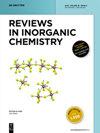Effluent wastewater technologies for textile industry: a review
IF 3.1
3区 化学
Q1 CHEMISTRY, INORGANIC & NUCLEAR
引用次数: 0
Abstract
The textile industry contributes significantly to the expansion of the world economy, however, it is also notorious for producing large amounts of trash and harming the environment. Effective waste management techniques depend on having a thorough understanding of the forms and makeup of waste from the textile sector. The objective of this paper is to study effluent wastewater technologies to efficiently treat and control the wastewater produced during textile production operations. It is well known that the textile industry generates vast amounts of wastewater, some of which may be contaminated with heavy metals, chemicals, dyes, and organic compounds. This effluent can have serious negative effects on the environment if it is not adequately treated, including contaminating soil and water sources, removing aquatic life, and possibly endangering human health. Due to the inclusion of dyes, heavy metals, and other chemicals, the discharge of untreated or improperly treated effluent from textile processes leads to water contamination. Textile waste can leak hazardous compounds into the environment and contaminate the soil, both of which have an impact on air quality. The environmental impact of the textile industry is further exacerbated by the energy and resource use involved in production. At several points in the textile supply chain, waste is generated. Fibre trimmings, fly waste, and yarn waste are produced during the fibre production, spinning, and weaving operations. There are numerous ways and technologies for treating wastewater, including advanced oxidation processes (AOPs), biological treatment systems, and membrane-based technologies. The formation of eco-friendly materials and advancements in recycling technology help to make the textile industry more closed-loop and sustainable. In conclusion, managing waste from the textile sector is a significant environmental concern that calls for creative solutions and environmentally friendly procedures.纺织工业废水处理技术:综述
纺织业为世界经济的发展做出了巨大贡献,但它也因产生大量垃圾和危害环境而臭名昭著。有效的废物管理技术取决于对纺织业废物形式和构成的透彻了解。本文旨在研究污水废水处理技术,以有效处理和控制纺织生产过程中产生的废水。众所周知,纺织业会产生大量废水,其中一些可能受到重金属、化学品、染料和有机化合物的污染。如果不对这些废水进行适当处理,会对环境造成严重的负面影响,包括污染土壤和水源、使水生生物消失,以及可能危及人类健康。由于含有染料、重金属和其他化学物质,纺织过程中排放未经处理或处理不当的污水会导致水污染。纺织废料会将有害化合物泄漏到环境中并污染土壤,这两种情况都会对空气质量造成影响。生产过程中的能源和资源消耗进一步加剧了纺织业对环境的影响。在纺织品供应链的多个环节都会产生废弃物。在纤维生产、纺纱和织布过程中会产生纤维边角料、飞边废料和纱线废料。处理废水的方法和技术有很多,包括高级氧化工艺 (AOP)、生物处理系统和膜技术。生态友好材料的形成和回收技术的进步有助于使纺织业更加闭环和可持续发展。总之,纺织业的废物管理是一个重大的环境问题,需要创造性的解决方案和环保程序。
本文章由计算机程序翻译,如有差异,请以英文原文为准。
求助全文
约1分钟内获得全文
求助全文
来源期刊

Reviews in Inorganic Chemistry
化学-分析化学
CiteScore
7.30
自引率
4.90%
发文量
20
审稿时长
1 months
期刊介绍:
Reviews in Inorganic Chemistry (REVIC) is a quarterly, peer-reviewed journal that focuses on developments in inorganic chemistry. Technical reviews offer detailed synthesis protocols, reviews of methodology and descriptions of apparatus. Topics are treated from a synthetic, theoretical, or analytical perspective. The editors and the publisher are committed to high quality standards and rapid handling of the review and publication process. The journal publishes all aspects of solid-state, molecular and surface chemistry. Topics may be treated from a synthetic, theoretical, or analytical perspective. The editors and the publisher are commited to high quality standards and rapid handling of the review and publication process.
Topics:
-Main group chemistry-
Transition metal chemistry-
Coordination chemistry-
Organometallic chemistry-
Catalysis-
Bioinorganic chemistry-
Supramolecular chemistry-
Ionic liquids
 求助内容:
求助内容: 应助结果提醒方式:
应助结果提醒方式:


